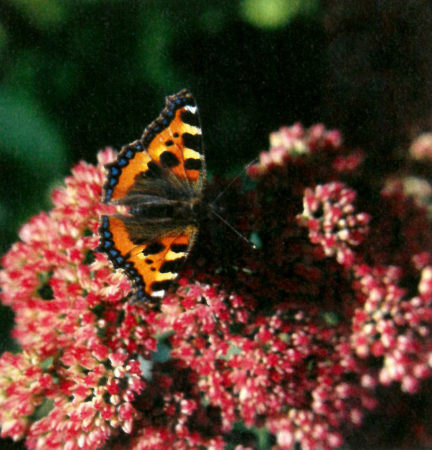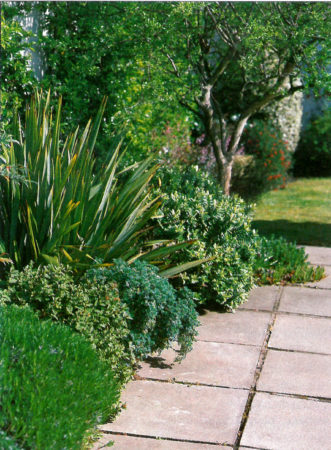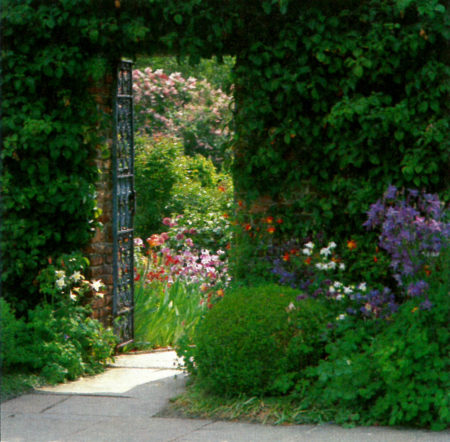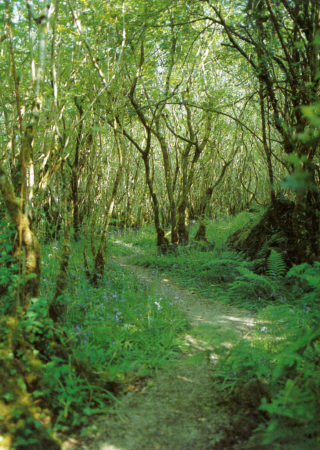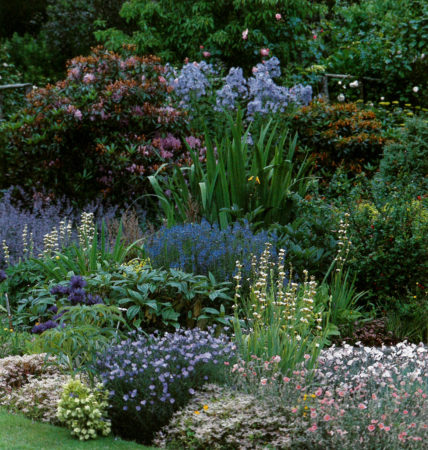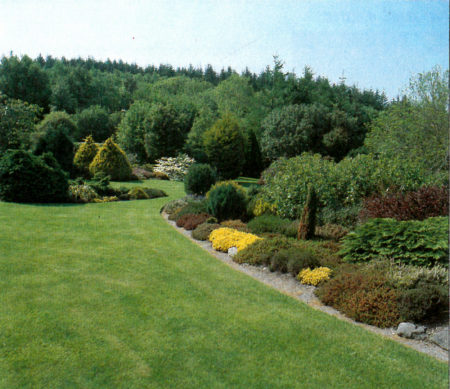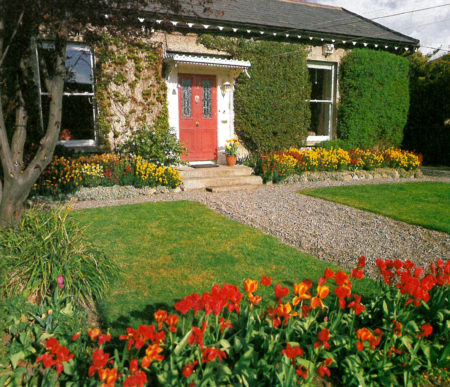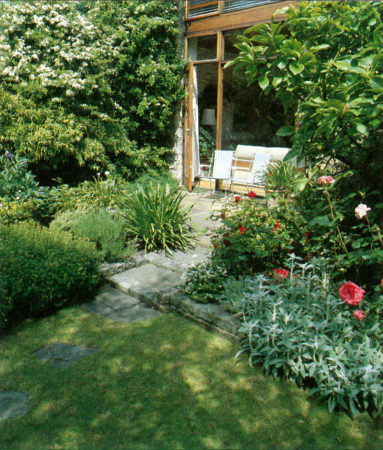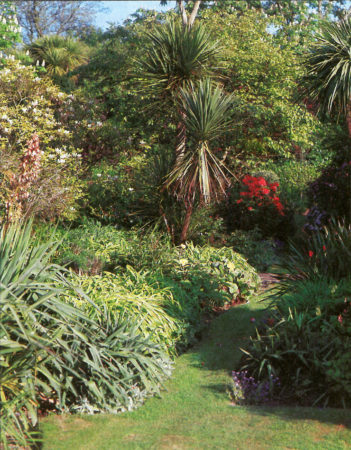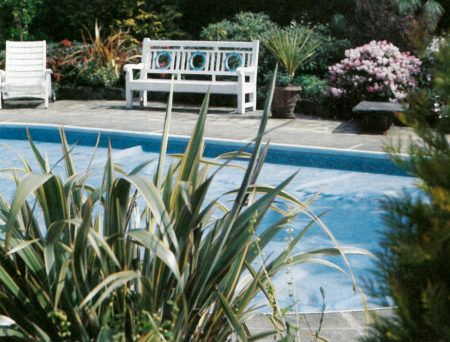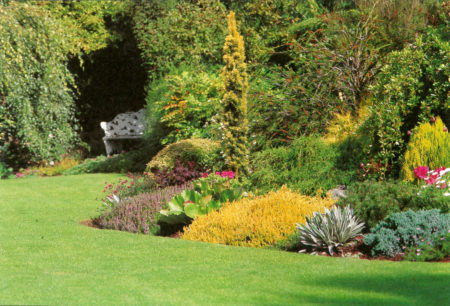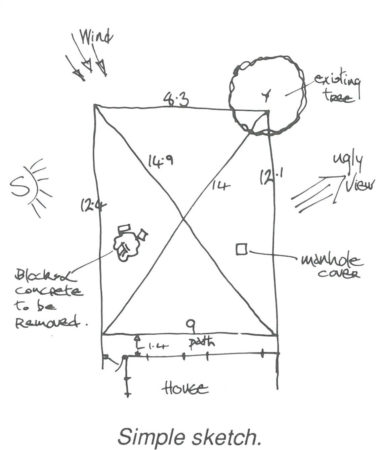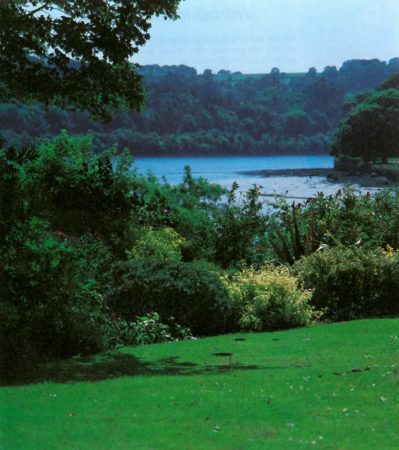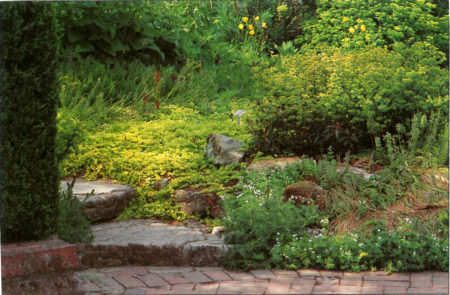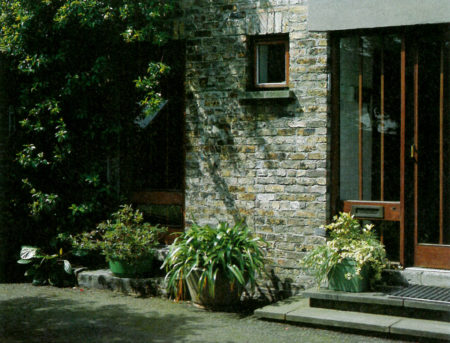Post category: Garden design
Gates and piers set the mood of the garden and the house. Cut-stone piers and wrought iron gates spell wealth; no gates implies an open attitude; high solid gates say – keep out!

Gates
Click here to view bigger sized image
Many modern houses, both in town and country have no gates at all, just entrance piers. Cattle grids have replaced gates in many rural gardens, but they hardly convey the same message as gates!
Gates and entrances to gardens should be in keeping with the rest of the garden in style and materials. For example, a wooden gate might be used if there is wooden fencing or trellis work in the garden.
!Garden gates!
Gates used within the garden can have the practical function of restricting access to certain areas. They might also be used to create a feeling of division between different parts of the garden.
Garden gates have an ornamental function too. A gate is usually quite a strong feature, its approach pathway tending to emphasise it. The gate and its approaches can be worked into a garden design to great effect. A ‘see-through’ gate can made a picture of what is beyond. A closed gate creates mystery.
Walls at the boundaries of the garden delimit the extent of the garden but they also provide privacy and security. These will be the highest walls in the garden, about 1.8 metres in the back garden; about one metre for front gardens.

Functional walls
Click here to view bigger sized image
Usually made of concrete, less often of stone or brick construction, boundary walls are generally regarded as a gardening liability. However, they can add considerably to the usable space in the garden when their vertical area is taken into account. This is especially true of enclosed town gardens. Very interesting schemes using climbing plants and trellis work can be created.
Retaining walls
Retaining walls hold back an earthen bank. They must be constructed properly with drainage holes every two metres and they must have a damp-proof-course at the back to prevent water seepage and structural deterioration. If they are more than one metre high, they might need reinforcing steel – ordinary blocks are not strong enough on their own – and an architect or engineer should be consulted.

Functional walls
Click here to view bigger sized image
Retaining walls define the area of ground that they support, separating it from other parts of the garden. Plants growing in the retained ground will be raised above the neighbouring area and this focuses attention on them.
However, plants grown at a retaining wall must not be of upright shape because they will look isolated. Some trailing plants to tumble over the retaining wall should always be used to link the raised plants with the rest of the garden.
Drystone walls
A drystone wall is made without mortar holding the stones together. In practice, some mortar is often used, or soil in place of mortar, but it is kept hidden at the back of the stones. Drystone walls used in gardens are rarely two-sided; they are usually used as low retaining walls to front a terrace.
Because they have little inherent strength, no heavy loading should be placed on drystone walls, nor should they be built higher than one metre. They should always be built with a slope back towards the soil face, and filled behind with rammed earth to stabilise them.
Balustrades and rails
Where there is a change of level at the edge of a terrace, even quite a small drop, balustrading or rails can be considered, both for safety and decorative value. A balustrade is a concrete or stone coping supported by small columns, called balusters. Rails can be of any material, concrete, timber or metal.

Functional walls
Click here to view bigger sized image
They have the advantage over a solid wall of being open, creating less enclosure. Balustrade gives a formal, somewhat old-fashioned feel to a terrace; rails are more modern, especially metal. Timber rails, especially peeled rustic poles, are suitable for natural gardens.
A decorative wall has no practical function, such as defining the property boundary or retaining earth, but the functions of division and ornament are just as important.

Decorative Walls
Click here to view bigger sized image
The main function is to divide the garden, defining each area and its treatment. A high wall might divide an internal garden or courtyard from the rest of the garden, creating a garden within.
The higher the wall, the more complete the division, but even a low wall can effectively define the edge of an area of paving, or perhaps a small internal garden, such as a rose garden. Apart from the function of creating division, high walls provide support for wall plants.
Low walls can be used to divide a flat garden in compensation for lack of natural changes of ground level. Ornamental walls should also be decorative in themselves, nicely made with a neat coping perhaps. The straight level lines of low walls make an excellent foil for the varied form of plants.
Walls must be there for a purpose; there is not much point in having a low wall just run across an area of lawn. However, if there is a little flower border to one or other side of the wall, or both sides, a reason for the wall is established.
Stone walls are appropriate for older gardens, and natural gardens. Well-built, plastered, dashed or sprayed walls suit a modern-style garden. Screen walls, made with open, screen blocks or by leaving gaps between solid blocks, are less enclosing than solid walls while still providing division.
Water brings unique qualities to the garden. It has movement and music, and mysterious depths. Its flat surface mirrors the shapes and colours of plants. The sight and sound of water has a soothing effect. A pool dominates the area of garden in which it is located, so it must never be just an afterthought. Very few garden pools are natural; most are excavated.

Garden Pools
Click here to view bigger sized image
An informal garden pool should have a curving, irregular shape, and must be made to look as natural as possible. The pool should fill a natural low point of the ground, or have slopes made around it. An informal pool is usually made with a flexible pool liner that takes the shape of the hole when it is filled, or a rigid pre-formed pool liner.
Hiding the liner around the edge greatly helps to make the pool look natural. This can be done with stones, overhanging paving, even grass sods. Planting should approach the pool on one or more sides. The open sides can have paving or grass.
A formal pool is of regular shape, rectangular usually, but a circle, square and other geometric shape is possible. A formal pool does not retain a regular shape unless the sides are of hard materials.
Formal pools are usually made of reinforced concrete, sealed with special compounds, or lined below the concrete with synthetic rubber liner. The surrounding edges must be formal too, usually paved. If there are associated areas of lawn, these are usually formal in shape with paved edges.
Cascades and fountains
In contrast to the calm silent water of a pool, a cascade or fountain has trickling, tinkling, tumbling, or splashy sound, depending on the volume of moving water. Water tumbling over a series of ledges in a cascade can be appropriately linked with an informal pool. The height of cascade should be no more than about one-third of the width of the pool at the point where it enters.

Garden Pools
Click here to view bigger sized image
Fountains shoot water into the air, creating shapes as well as sound. Although often used with informal pools, they are most appropriate to a formal pool, itself an artificial shape. In the right setting, usually as a centrepiece, a fountain is a very effective garden feature.
Bog garden
An area of wet soil, naturally flooded on occasion, can be turned into a bog garden, or it can be deliberately flooded to grow bog plants. The term ‘bog’ has nothing to do with peat; a ‘marsh garden’ might be a more accurate phrase. A naturally marshy spot fed by a small stream, or by springs, is ideal.
Alternatively, the soil of a low-lying area, perhaps bordering a garden pool, can be dug out to a depth of about 30 centimetres and lined with a good quality pond liner. The soil is replaced and a permanent water supply laid on. If there is a pool, an overflow might be set up. Otherwise a length of plastic pipe, drilled to leak evenly, might be laid just beneath the soil surface.
A bog garden area can prove difficult to maintain because weeds are very vigorous when well watered. It is best to start with clean ground and put in lots of bog plants to quickly cover the soil. If the area is large, provide access in the form of a wooden walkway, or stepping stones across which planks can be laid to facilitate weeding.
Though a garden does not immediately come to mind as a wildlife habitat, most of its animal life is every bit as wild and untamed as anything the jungle ever produced – less spectacular that’s all. Even if birds or hedgehogs become used to being fed, they remain wild animals.
Wildlife
Click here to view bigger sized image
Unnoticed hordes of creatures work in the soil, on its surface, and on plants. Some are plant-eaters (herbivores); others are scavengers of dead animal and plant tissue; a few others are carnivores that eat the herbivores. Certain small animals, mainly insects and mites, are parasitic on larger animals, feeding off them or laying eggs in them.
Relatively few insects, and other animals, have managed to breach the formidable defences of plants – thorns, hairs, stings, sticky surfaces, tough skins, poisons. Of the hundreds of animal species found in gardens, very few are truly harmful to plants. Most are there to feed off dead plant material, or off each other.
The relatively small number of harmful insects; greenflies, some caterpillars, a few beetles and grubs, we recognise easily. The ones we have no names for tend to be disregarded. These are the beneficial insects that turn dead plant material into humus and, by and large, control the harmful insects.
Birds are particularly valuable for their predatory role on insects and snails, as well as for their singing. Some insects play a dual role. For example, wasps are a nuisance but they are also implacable predators of caterpillars; earwigs chew holes in flowers but they eat greenflies too.
Trees and shrubs, particularly berried kinds, provide shelter and food for birds. Flowers and other plants encourage insects. A pool encourages slug-eating frogs.
Exotic
Native plants are those which were not introduced by mankind. During thousands of years, they have adapted to the prevailing climate and they are resistant to most local pests and diseases.
Native and Exotic
Click here to view bigger sized image
Although this makes them very reliable garden plants, they are not often used because of their ‘wild’ status, which is a pity because they need no care when given the right conditions. They are particularly valuable for linking a garden with the surrounding ‘wild’ countryside.
Natural landscape
The natural landscape has always inspired gardeners. Hills, forests and lakes – the whole of the natural landscape can be viewed as a great garden. It is just as important to view the garden as part of the landscape. Let the landscape into the garden and make sure the garden fits the landscape.
In an urban landscape, the garden will normally fit in relatively easily. In rural areas, the garden can be used to fit the house into the surrounding countryside and the plants used should not jar with their surroundings. For instance, pink cherries are too artificial for the surrounding countryside. If these are used, they should be contained within the garden.
People are very sensitive to the natural world and this applies to the garden environment too. Our innate sense of danger has a big influence on garden design. We are much more comfortable with our backs to a solid barrier; when looking down from a height; or when hidden from view, looking out.
People and Nature
Click here to view bigger sized image
Any sitting area in the garden will feel uncomfortable unless it is backed by walls, fences, trellis or hedges, even low ones. A barrier is comforting.
Despite high walls, if a sitting area is overlooked, it will feel uncomfortable too. A screen, however flimsy, above eye level provides a good hide-away. A raised terrace, or platform can be uncomfortable if it exposes the sitter, even without being overlooked. However, a terrace with the solidity of the house directly behind feels comfortable.
To lend the garden a feeling of seclusion and comfort, it is very important to provide at least one sitting area that is not overlooked or open. People never sit in the front garden if they have a back garden!
Mountain
The web of life in the garden is as complex and dynamic as any in the wild, natural world. An understanding of the world of plants makes gardening easier and more successful. Plants grow over most of the earth’s land area, from steaming jungles to frozen tundra, even below the ocean surface and at the top of high mountains.
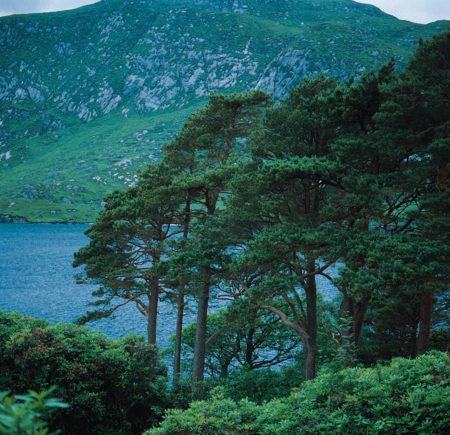
Natural Habitat
Click here to view bigger sized image
The conditions of soil, climate and animal life to which a plant has adapted define its habitat. Plants have adapted to tolerate every kind of habitat, which means that plants exist to suit the conditions in any garden.
Woodland
Woodland conditions are created by the canopy of trees. Height gives the tallest trees first call on available light and moisture; as little as twenty percent of sunshine and rain actually gets through to the forest floor. Deep roots of trees penetrate to the subsoil where plant nutrients unavailable to shallow rooted plants are found.
Natural Habitat
Click here to view bigger sized image
When the leaves fall from the canopy, they smother small plants on the woodland floor, further reducing competition. These advantages have made trees the dominant, or ‘climax’, vegetation across vast areas of the earth’s surface.
Within gardens, every tree or shrub that casts shade; every building that approximates a cliff-face, or wall a boulder, creates woodland conditions. Therefore, we must look to woodland plants to thrive in shady places.
Plants have adapted to take advantage of the trees’ success. Climbers and creepers climb to the top of the tallest trees to get a share of the light. Many woodland plants have dark-green leaves with more chlorophyll to trap the available light. Evergreens have full access to the light when the leaves are off the canopy.
Bulbs come up early in spring to grow and flower before the tall trees are in leaf, and they enjoy the annual mulch of fallen leaves. Ferns enjoy the sheltered, humid atmosphere and protection from the scorching heat of the sun.
Many woodland plants have edible nuts (hazel, beech, sweet chestnut), and fruits (crabapple, cherry, holly, ivy, elderberry) to encourage woodland birds and mammals to carry them to new territory. These plants have attractive flowers and berries and they can be used to attract wildlife to the garden.
Grassland
There are large natural grassland areas where grazing animals prevent the transition to forest by grazing young saplings. Trees and shrubs never get the chance to build up their woody structure. Grasses and herbaceous perennials with stems at ground level, or below it, survive.
Natural Habitat
Click here to view bigger sized image
In the garden, the lawnmower achieves the same effect as grazing animals in nature. Well adapted low-growing perennials survive even better than grasses. These are the weeds of fine lawn – the wild flowers of wildflower meadows.
Moorland
Moorland is flat and windswept with free-draining, poor soil, usually acidic. This land supports heathers, furze and broom; hard, fine-leaved grasses such as fescues; certain trees like birch, pine, mountain ash and juniper.
The plants are wind-resistant and can survive dry conditions. Dry moorland is the model for heather-and-conifer gardens.
Wetland
River’s edge and marshland have provided a lot of interesting garden plants. Woody plants like willow, poplar, alder and dogwood are at home in these conditions; they are adapted to having their roots in damp ground. Sweet flag, kingcups, meadowsweet, purple loosestrife and globeflower are native lovers of damp conditions.
From abroad, there are thousands of excellent garden plants that enjoy such conditions; many of them enjoying partial shade as well because they will usually be competition from trees in such habitats. Astilbes, hostas, bergenias, ligularias, asian primulas, certain irises, easter lily, and hardy geraniums are examples. An area of damp ground need never by a problem with plants like these to grow in it.
Other natural plant habitats
The seashore has its own set of wind and salt resistant plants life thrift, creeping thyme, sea holly, and burnet rose. From foreign seashores come sea buckthorn, olearias, hebes, griselinia, phormium, fuchsia and various pines.
Mediterranean and Middle-eastern countries have large expanses of dry, rocky moorland with sage, thyme, vines, lavender, cistus and many bulbous plants like tulips, cyclamen, foxtail lily, and gladiolus.
The arid desert regions have plants like cacti and succulents specially adapted to tolerate long periods of drought. They make very good windowsill plants indoors. From tropical jungles come plants that are used to heated air and low light – ideal houseplants!
Woodland edge
Most gardens approximate to a woodland edge where grassland joins woodland, and the paved areas are like rock outcrops. In similar natural situations, every type of plant will be represented – trees, climbers, shrubs, perennial flowers, grasses, and annual plants. Plants make layers of vegetation – trees, shrubs, and non-woody plants.
Natural Habitat
Click here to view bigger sized image
Though every sort of plant will be present, it is surprising how few of each type will be found at any one location: four or five kinds of trees, a few climbers, five or six shrubs, perhaps ten non-woody perennial plants and a few annuals.
Several lessons may be drawn from studying natural plant groupings: plants thrive where the conditions suit them; all the ground is colonised by plants – the different types of plants grow together; and wildlife abounds.
House Style
The garden should always match the style of the house. Old houses should have something of the garden style appropriate to their age. Of course, it may not be possible to restore this exactly, because labour was very cheap then, but some few features of the fashion of former days will look right.
A Victorian house might, for example, have some dark broad-leaved evergreens, hedges, a gravelled path or two, and some small box-edged flower beds.
A modern house would look ridiculous with those garden features. It should have a free-flowing style – a few well-chosen, carefully placed trees; good-sized groups of mixed planting, lots of ground-cover and some dramatic individual plants. This is a ‘clean’, modern style in keeping with modern architecture.
A large house will need big plants to balance it. However, on a restricted site, a lot can be done with creepers and tall, narrow trees to make a large house sit more comfortably.
Garden style
Although the style should match the house, this is really a matter of personal taste. Usually, the taste that informs the choice of home fittings and decoration will exert the same influence on the garden.There are as many styles as there are people but the choice might resemble one of the following types: a simple, strong style (paving and a few plants), a quiet, retiring style (lawn, hedges and rose beds), a brash, show-off style (lots of bright bedding and window boxes), or a fussy, homely style (lots of pale coloured flowers and bulbs, mixed with shrubs).
Needs
Plants can be dangerous – poisonous, sharply spined, or just badly placed where the unwary might trip.
The garden can be made enjoyable for every user. Smooth, firm surfaces and gentle slopes for those who find it hard to get about; safe play areas for children; comfortable shade for the elderly (and the fair-skinned!); raised beds for those with difficulty in bending; scented plants for the blind.
Function
The garden has an important ornamental function, providing pleasant surroundings for the home, an attractive scene for the passerby. Leisure uses are an important function – sitting out, sunbathing, strolling, entertaining, children’s play, even sport like tennis, or swimming (if you have a pool!)
The garden can be used for keeping pets – cats, dogs, fish, even bee-keeping in rural areas. The production of fresh fruit, vegetables and herbs can be considered an important function for the garden; cut flowers for indoor decoration may be required.
The garden may be required to hold a hobbyist gardener’s collection – alpines, roses, bonsai and many others. There is also the opportunity for self-expression, arranging plants to achieve desired effects of colour and form.
Practical functions like the clothes-line, fuel tank, tool shed, compost heap, and possible septic tank must be taken into account and placed where they are convenient without spoiling the garden.
Everybody has their own favourite plants – trees, dwarf conifers, heathers, rockery plants, bog garden plants, or favourite flowers such as sweet peas, roses, lilies, irises, and thousands of others.
Make provision for your favourites in terms of space and suitable conditions
Click here to view bigger sized image
Make provision for your favourites in terms of space and suitable conditions. Favourite plants can influence other aspects of the garden design. For example, an interest in climbing roses, or clematis, will necessitate fences, trellis or walls on which to grow them.
Some choices will rule out others; it is not possible to fill the garden with trees and still have a decent lawn, or rockery with alpine plants, because of the shade they cast, but it would be possible to have a fernery, for instance.
As with plants, everybody has favourite garden features. Most people like to have a paved area, others like a water feature, or containers, statues, drystone walls, scree beds, garden lighting, balustrades and steps, pergolas, timber seats, imposing gate pillars, fountains, secret gardens, trellis fences, even garden gnomes!
A five-acre garden will accommodate all of these and a multiplicity of plant preferences as well. Small gardens are more limited, and it is best to stick to a few firm favourites, and not to try to fit in too much.
Professional advice can be sought and will cost a certain amount of money, but it will be money well spent. Any garden designer will testify that they are frequently called in when mistakes have been made, and money has been unwisely spent.
Some garden features cost more than others. Lawns are the cheapest garden feature; they even sow themselves as ‘tumbledown’ if left to their own devices! Conservatories, paving, walls, terraces and water features are among the more expensive features.
In general, plants are cheap compared to non-living features like paving, walls and fences. Bedding plants are often considered cheap compared to more permanent trees, shrubs and perennial flowers. However, the expense of three or four boxes of bedding plants each year is equivalent to one decent tree, three or four shrubs and perhaps eight or ten perennial flowers. Perennial plants not only grow in size each year, but new plants can be raised from cuttings, or by division.
Money can make up for lack of time available by paying to have the garden made and maintained by a contractor. Equally, if you have plenty of time available, you can save money by do-it-yourself construction and the propagation of plants from seeds and cuttings.
Space
Where there is room for large plants, small plants never achieve the desired result, even when used in numbers.
Where there is room for large plants, small plants never achieve the desired result, even when used in numbers
Click here to view bigger sized image
Equally, care must be taken not to use over-large plants in a small garden. There are plants suitable for every size of garden. Usually, there isn’t much can be done about the amount of space available; the challenge is to use it to best effect.
Time
Some garden features are very time-consuming – large lawns, hedges, rose beds, bedding plants, containers, rockeries, fruit and vegetables. On the other hand, trees, shrubs, most perennial flowers, ground-cover, walls and fences, paved areas, scree gardens, small lawns, wildflower meadows, and pools have lesser time demands. See Labour Saving.
Each square metre of lawn will need about three minutes each year for mowing alone; there will be feeding and lawn edging as well. If you have a quarter-acre to mow, the annual total will come to seven eight-hour days!
Each square metre of trees and shrubs can be maintained in about twenty seconds per year, or six hours for the same quarter-acre. Remember also that the trees will need less time as they mature; the gardener maturing at a similar rate.
Plan
Make a sketch of the site on a piece of paper marking in all the existing objects and features. Measure the size of the garden, either by pacing it roughly, or using a tape. Take diagonal measurements from corner to corner to give the correct angles made by the boundaries.
Make a sketch of the site on a piece of paper marking in all the existing objects and features.
Click here to view bigger sized image
Very few plots have right angle corners! Measure existing buildings, paths, driveways and walls. Measure the position of trees from walls or the house itself. Note the spread of their branches. Record other plants, flower beds and lawns, if these are to be retained. All drains, wires and septic tanks should be accurately recorded. Take note of the position of the sun at midday.
Using the rough sketch of measurements and other notes, draw a reasonably accurate plan of the garden site. A drawing of the garden to scale is an invaluable part of the process. The simple sketch can do well enough but not being to scale, it can be misleading.
The drawing allows various ideas to be tried out on photocopies; it gives a better chance of getting things into correct proportion, and it acts as a record of planting for the future.
Use a large sheet of paper to draw a garden plan. It is much easier to draw on a large scale than a small one where there will not be enough room to display individual plants properly.
Viewed from above, nearly all plants look circular in outline; therefore, a circle on the sheet of paper will represent a tree or shrub very well. Mark a heavy dot in the middle for the trunk. If there are several plants of the same kind in a group and they are growing into each other, the group can be represented by the appropriate number of overlapping circles. Each plant’s position can be marked with a dot, a cross, or a small ring.
Buildings, walls, fences and pathways when viewed from above look like squares, rectangles, straight lines, parallel lines and curving lines, as appropriate. These shapes can be used to represent such objects in the garden plan.
Drawing to scale
A plan drawn to scale is very much like an aerial photograph of the site taken directly above it. Imagine a bird’s eye view looking straight down.

A plan drawn to scale is very much like an aerial photograph of the site taken directly above it
Click here to view bigger sized image
Allowing one centimetre to each metre (or step) measured, gives a one-in-one hundred scale; two centimetres to each metre gives a one-in-fifty scale. One centimetre in a 1:50 drawing would be equivalent of fifty centimetres of actual garden.
It is then easy enough to assess how much space there is available in any given spot, and to instantly know whether a two-metre wide shrub will actually fit; it would need four centimetres on your drawing. If there is only two centimetres available, it will be too big in five years time!
Size
The size of the garden is a very important factor in deciding which features and plants to use. From the plan measurements, work out the area of garden. This may also be available from the documents of sale for the property, or architect’s drawings.
Soil
The type of soil should be noted. Dig a hole about 50 centimetres deep and 50 centimetres wide. You will be able to see what depth of dark top-soil there is. The subsoil is much paler than the top-soil, it is quite poor. If it is nearly as brown, then it is good soil – suitable for everything. If the subsoil is bluish and sticky, the ground is waterlogged and only plants that like wet ground can be grown.
Examine the soil for structure. Is it crumbly and open, or heavy and sticky? Has it a lot of stones, or is it sandy or clayey? Feel the soil between your fingers to decide on this. Sandy open soils are easy to work but tend to dry out in summer. Sticky clay soils are often fertile but lumpy and heavy to work. The ideal is in-between.
A soil test should be done to see if it is acid or limey. Test kits can be got in any garden shop. Pink or red flowers on hydrangeas indicate a limey soil; blue flowers, an acid one. Purplish hydrangeas indicate a neutral soil – neither acid nor limey. Rhododendrons in local gardens growing in the open ground will confirm acid soil. Soil does not change very much within the immediate neighbourhood, but a test will make sure.
Drainage
The ability of the soil to allow water to drain away is very important. Winter is the best time to assess drainage. Dig a few holes and see if they fill with water and how long it takes to drain. A useful rule of thumb is to note whether water lies on the surface for more than one full day after heavy rain stops. It if does, steps should be taken to improve drainage by means of a soak-hole for small areas, or plastic drainage pipes to a proper outfall on larger sites.
Slope
Record any significant slope, where it begins and how much of a fall there is. This will affect drainage but will also have a major influence on how the ground is finally laid out. The amount of slope can be accurately measured by moving along a line of pegs set at regular intervals with a straight length of timber and a spirit level.
Record the drop at each peg. The total figure for all the pegs gives an accurate measure of the fall. This will be especially important where it is necessary to estimate the height of terraces or retaining walls.
Site clearance
Site clearance may be necessary. Gather stones or builder’s debris by hand, or it can involve the removal of old buildings, stumps or other obstacles with power machinery. Before moving any obstacles, first consider how it might be used as part of the garden design, avoiding the need for removal.
Assess the need for earth-moving, such as levelling bumpy ground or making a slope less steep, or making terraces on sloping ground. The killing of existing stumps, scrub and perennial weeds, like nettles, docks, briars and bracken, can be necessary, and this should be noted.
Microclimate
Each location has its own special climate. If your garden is on the south-facing side of a hill, it will be sunny and warm. If you are at the top of a hill, wind exposure will be greater but, in its favour, an elevated site usually has nice views. Near the sea, salty winds can do a lot of damage, but a seaside garden suffers less frost.
Find out if the site is in a frosty locality. Areas within a few miles of the coast are less prone to frost; inland gardens are much colder. The presence of full-grown cordyline palms is a good indicator that the area is not frosty.

Work out the direction of the prevailing wind; mostly, it is from the southwest, but it can be influenced locally by the layout of the street, or nearby hills. Established trees will give a good indication of wind strength and direction; they lean away from strong winds. Noise from roads, or factories, can be a factor to consider. Dust can sometimes be a nuisance, too. Trees help to reduce both of these problems.
A successful design is one that is pleasing to the garden owner. There is room in gardening for every taste and no such thing as the ‘right’ way to do a garden. However, no matter what style is favoured, or taste is satisfied, there is such a thing as ‘good’ design – design that it is pleasing to a wide range of people, besides the owner.
Some people are instinctively good at design, any sort of design. Others have to think carefully about their efforts. It is useful to consider the elements of garden design – size, shape, colour and texture, space, light and shade, mystery and focus, unity and variety –
because they give some guidance on how to proceed.
Everything done with the garden counts as a design decision; even if we decide to do nothing at all, it is design by default!
Decisions about the features used, their position, and construction must be taken at every stage. Very often, such decisions are made instinctively, or by following a traditional formula, even if it is a bad tradition, such as planting a tree in the centre of a small lawn. It is worth giving active consideration to every decision, especially the really major ones. Every decision has consequences in terms of expense, time and maintenance.
It is not suggested that the positioning of every single plant must be agonised over; that is the other extreme. Instinct and taste must be trusted in making decisions, but they should be informed by some careful thought.
There are two questions to ask about any garden feature or plant. ‘Why am I using this feature, or plant?’ ‘Is this the best way to do the job?’ There should be good reasons why a feature or plant is being used; there should be good reasons for doing a job in a particular way.


